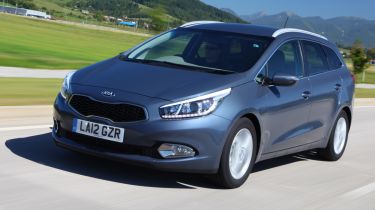Kia Cee’d Sportswagon
New Kia Cee’d Sportswagon offers the style and space to battle the Focus and Golf estates

The Cee’d Sportswagon delivers on space and comfort, even if it isn’t as stylish as the hatch, and the rear seats could be easier to fold. It’s nicely refined and comfortable, too, although a bit more power would be nice. Then there’s the price – Kia’s aren’t cheap anymore. Which stacks them up against some seriously talented opposition, some of which drive better and can be bought more cheaply.
With SUVs and MPVs grabbing all the headlines, it’s easy to forget the humble old estate car. It’s a simple recipe, which, when done well, can make a huge amount of sense. So hot on the heels of the new Kia Cee’d hatch comes the estate version: a little less stylish, a bit more expensive, but a whole lot more spacious.
Of course, estates don’t have the coolest image, so Kia calls its latest model a Sportswagon – lengthened from the old Cee’d in more ways than one: it’s 15mm longer, and the old car was simply called SW.
The new car is narrower and lower than before, looking more like a stretched coupe than a boxy estate, in profile at least. From that interesting front end, with Kia’s tiger nose grille, it goes downhill the further back you go with a disappointingly bland rear end.
Used - available now
Yet, inside that wide opening tailgate is a minimum of 528 litres of space, which can be stretched to a maximum of 1642 litres. Those stats are slightly down on the old SW, but 148 and 324 litres up on the hatch and bigger than both a Focus and an Astra estate.
It’s as clever as you’d hope, too, with the boot floor flush to the tailgate opening for easy slideinability, and secret spaces under the floor (although now we’ve told you, they’re clearly not secret any more). The rear seats (split 60/40) fold flat, too, but you have to tumble the seat bases out of the way first – a bit of a faff these days.
Handy rails and boot dividers are available, though, but only on top spec models. Every version gets net hooks, a 12v socket in the boot and roof rails, too.
Kia has made it easy to choose a trim level: 1, 2, 3 or 4. There’s a 4 Tech, too, with all the bells and whistles, but it costs astonishingly close to £25,000. The Cee’d is good, but it ain’t that good.
You’re better off sticking to the still reasonably equipped 1 or 2 models – the former getting all you really need (air-con, remote locking, iPod and Bluetooth connectivity), with the 2 adding things like LED daytime running lights and added chrome for a more upmarket look, plus some leather trim on the steering wheel and gear lever.
Whichever trim level you go for, you’ll be impressed by the quality inside. The new Golf may have just raised the bar again, but the Cee’d is at least as good as a Focus with an attractive design and easy to use controls.
There’s plenty of space, too, with good knee and head room in the back for adults and okay width for three.
Wisely, Kia hasn’t bothered offering a petrol version, a clear indication that fleets are likely to be the biggest customers. You can have a 89bhp 1.4-litre that’s tuned more for economy than performance (67.3mpg and 109g/km of CO2 is impressive, 0-60 in 13.4 isn’t) and is only available in 1 trim for £16,895. Or you can have the 126bhp 1.6, starting from £17,695, which we drove.
It’s still no ball of fire and won’t get anywhere in a hurry, especially if it’s loaded up with people and stuff. The power delivery is smooth, though, and the ride is reasonably comfy, too.
The steering’s not especially sporting either: why Kia bothers with its Flex Steer system (offering comfort, normal and sport settings) is beyond us. None offers great feedback, or much difference if truth be told.
Maybe the Cee’d estate should be called Comfortwagon instead – that would be more fitting, but a whole lot less sexy.












